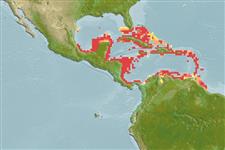Environment: milieu / climate zone / Mức độ sâu / distribution range
Sinh thái học
Biển; Thuộc về nước lợ Cùng sống ở rạn san hô; sống cả ở nước ngọt và nuớc mặn (Ref. 51243); Mức độ sâu 0 - 84 m (Ref. 13608), usually 1 - 15 m (Ref. 9268). Subtropical; 26°N - 7°N, 97°W - 58°W (Ref. 118624)
Worldwide in warm seas. Hawaiian species have been verified by electrophoretic analysis (Ref. 5577), hence, Albula vulpes might be further split. Eastern Pacific: California, USA to Peru (Ref. 2850). Western Atlantic: North Carolina, USA to Florida, Bahamas, Gulf of Mexico, Antilles and Caribbean to Brazil (Ref. 26938). Northwest Atlantic: Canada (Ref. 5951). The West African form is Albula goreensis, Valenciennes, 1846.
Length at first maturity / Bộ gần gũi / Khối lượng (Trọng lượng) / Age
Chín muồi sinh dục: Lm 37.5, range 21 - 36 cm
Max length : 104 cm TL con đực/không giới tính; (Ref. 7251); Khối lượng cực đại được công bố: 10.0 kg (Ref. 37955)
Các tia vây lưng cứng (tổng cộng) : 0; Các vây lưng mềm (tổng cộng) : 15 - 19; Tia cứng vây hậu môn: 0; Tia mềm vây hậu môn: 7 - 9; Động vật có xương sống: 69 - 74. Branchiostegal rays 12-14 (Ref. 4639). Silvery with dusky fins; base of pectorals yellow (Ref. 3970). Body elongate and fusiform (Ref. 4832). Last ray of dorsal and anal fins not prolonged; head region naked; spot and band absent on head; margin of nasal pore not black (Ref. 13608). Bluntly conical snout extends beyond inferior mouth (Ref. 26938). Pectoral and pelvic axillary scales present; a single long scale on each side of membrane between each ray of dorsal and anal fins (Ref. 4832).
Body shape (shape guide): fusiform / normal.
Inhabits shallow coastal waters, estuaries and bays, over sand and mud bottoms (Ref. 3237). Often in schools, except large individuals which are solitary (Ref. 7251). Dorsal fin may show above surface (Ref. 42064). More or less pelagic but feeds on benthic worms, crustaceans, and mollusks (Ref. 2850); that are picked from mud and sand bottoms (Ref. 27549). Tolerates oxygen poor water by inhaling air into a lung-like airbladder (Ref. 9710). Flesh is bony and not esteemed (Ref. 9268). One of the most important game fishes worldwide (Ref. 26938).
Spawning occurs in open waters. Eggs are pelagic (Ref. 205).
Whitehead, P.J.P., 1990. Albulidae. p. 122-124. In J.C. Quero, J.C. Hureau, C. Karrer, A. Post and L. Saldanha (eds.) Check-list of the fishes of the eastern tropical Atlantic (CLOFETA). JNICT, Lisbon; SEI, Paris; and UNESCO, Paris, Vol. 1. (Ref. 4447)
IUCN Red List Status (Ref. 130435: Version 2024-2)
Threat to humans
Reports of ciguatera poisoning (Ref. 4690)
Human uses
Các nghề cá: buôn bán nhỏ; cá để chơi: đúng; mồi: usually
Các công cụ
Special reports
Download XML
Các nguồn internet
Estimates based on models
Preferred temperature (Tài liệu tham khảo
123201): 20.4 - 28.4, mean 27 °C (based on 1501 cells).
Phylogenetic diversity index (Tài liệu tham khảo
82804): PD
50 = 0.5007 [Uniqueness, from 0.5 = low to 2.0 = high].
Bayesian length-weight: a=0.01230 (0.00895 - 0.01691), b=3.02 (2.93 - 3.11), in cm total length, based on LWR estimates for this species (Ref.
93245).
Mức dinh dưỡng (Tài liệu tham khảo
69278): 3.7 ±0.3 se; based on diet studies.
Thích nghi nhanh (Tài liệu tham khảo
120179): thấp, thời gian nhân đôi của chủng quần tối thiểu là 4.5 - 14 năm (K=0.3; tm=2; tmax=20).
Fishing Vulnerability (Ref.
59153): Moderate vulnerability (40 of 100).
🛈
Climate Vulnerability (Ref.
125649): High to very high vulnerability (66 of 100).
🛈
Nutrients (Ref.
124155): Calcium = 16.1 [8.5, 47.7] mg/100g; Iron = 0.503 [0.283, 0.890] mg/100g; Protein = 19.8 [18.7, 20.9] %; Omega3 = 0.258 [0.146, 0.453] g/100g; Selenium = 21 [11, 40] μg/100g; VitaminA = 23.8 [7.7, 79.0] μg/100g; Zinc = 0.641 [0.446, 0.942] mg/100g (wet weight);
